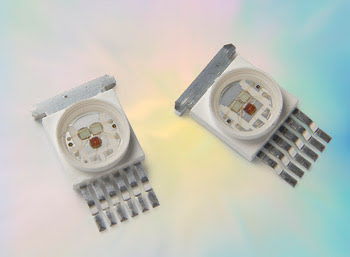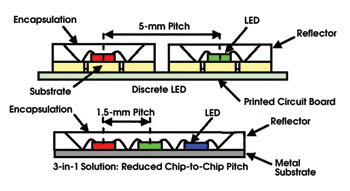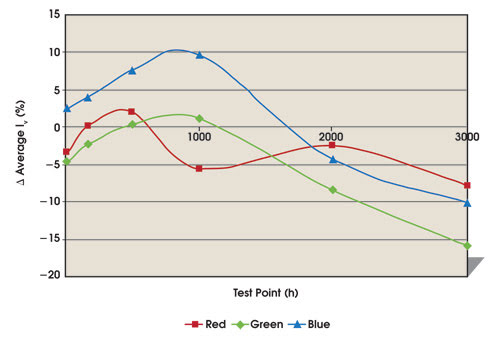Siang Ling Oon, Avago Technologies
In a world that is becoming more and more green-oriented, makers of LEDs are looking at red, green and blue (RGB) devices as energy-saving solutions for illumination applications. LEDs are making their mark in many areas, and one of the most promising – and fastest growing – is illumination.
Thanks to its excellent color saturation and energy savings, the LED is rapidly penetrating this market and promises to meet the demand for longevity and reduced-energy “green” products. In response, many manufacturers of lighting devices are using combinations of red, green and blue LEDs to provide a rainbow of desired colors.
However, using discrete LED packages in these applications is not without its problems, including the space wasted to accommodate the package structures and the extra effort required to provide effective color mixing from widely separated light sources. As a result, the market is beginning to look for three-in-one LEDs, or a combination of red, green and blue chips in a single integrated package; for example, the Moonstone package from Avago Technologies of San Jose, Calif. (Figure 1).

Figure 1. The three-in-one RGB Moonstone LED package (ASMT-MT00).
Illumination trend
RGB LEDs are playing important roles in a number of market segments, including architectural lighting, entertainment, wall washing, decorative lighting, outdoor facade lighting and video walls. In RGB applications, blue and green are the most commonly used colors in terms of revenue, where their ratio to red units is at least 2:1. To date, there are only a few LED manufacturers who offer a three-in-one package.
The conventional RGB approach is to use separate, discrete packages for each color, arranging the packages on a printed circuit board to achieve an RGB light source. However, applications such as architectural, entertainment, outdoor facade and decorative lighting will be more challenging for secondary optic designs, including a collimated lens for RGB that is used to illuminate an area some distance away. The lens and printed circuit board sizes will have to be increased once the pitch size between the LEDs increases. At the same time, the cost of a secondary optic design and material also will increase.
In contrast, the three-in-one approach directly mounts the RGB LED die into the same package. Each die can be individually addressed, which means that each has its own electrical channel to provide a range of colors. This enables the light source to be compact, compared with separately packaged devices, and the pitch between individual light sources to be significantly reduced, which is important in achieving the best color quality. The minimum pitch required for LED light sources to achieve good color mixing is approximately 5 mm. The three-in-one approach reduces the pitch to as close as 1.5 mm (Figure 2). Once the pitch is reduced, the area required for effective color mixing also is reduced. The effect of RGB stray light also will be minimized when approaching white color.

Figure 2. The three-in-one package design takes the common pitch size of 5 mm down to 1.5 mm.
In the Avago three-in-one package, high-performance polyphthalamide plastic is used as both the package housing and the reflector. This material can operate under conditions of high-temperature, high-UV light levels for long periods while maintaining surface reflectivity. If the wrong material is chosen as a reflector, however, the light output performance can drop significantly because of its white surface, which becomes yellowish or brownish over time after experiencing high temperatures.
A copper lead frame (substrate) enables the lowest thermal resistance. The heat generated by the operating LED chips can be efficiently transferred to the heat sink through the frame. Copper’s thermal conductivity is superior to other LED substrate materials, including ceramic, mild steel and aluminum.
Thermal performance and reliability
The thermal resistance has been verified using the Flotherm computational fluid dynamics program from Flomerics Group plc of Hampton Court, UK. In the simulation model, the reflector, lead frame, encapsulation, die attach layer and die were created, and a 1-W power source was placed on top of each die.
The simulated thermal resistance from junction to pin (Rjp) for the RGB die is 23 °C/W, 20 °C/W and 20 °C/W, respectively. These values have been verified by actual measurement using the forward voltage method, the results of which are very close to the simulation. The package thermal performance also has been validated through operating life tests of up to 3000 h.
Reliability testing was performed in a temperature chamber and showed low degradation after 5000 h at 100 °C operation (Figure 3). The InGaN die show an ~12 to 18 percent Iv drop and the AllnGaP die, a 10 percent Iv drop.

Figure 3. Reliability testing done at a high temperature for 5000 h showed low degradation of the LEDs.
The three-in-one package solution offers better characteristics than conventional discrete LED packages – including color mixing and space requirements – and features good thermal performance and reliability. It also provides greater flexibility for system designers.
Acknowledgment:
The author thanks Mok Thye Linn and Chia Chee Wai for their input and support.
Meet the author
Siang Ling Oon works in the research and development department of the Optoelectronic Product Div. of Avago Technologies in Malaysia; e-mail: [email protected].